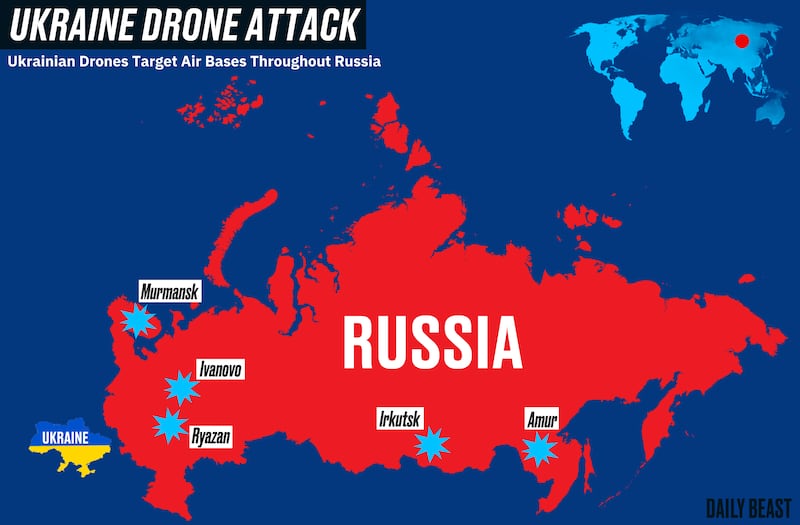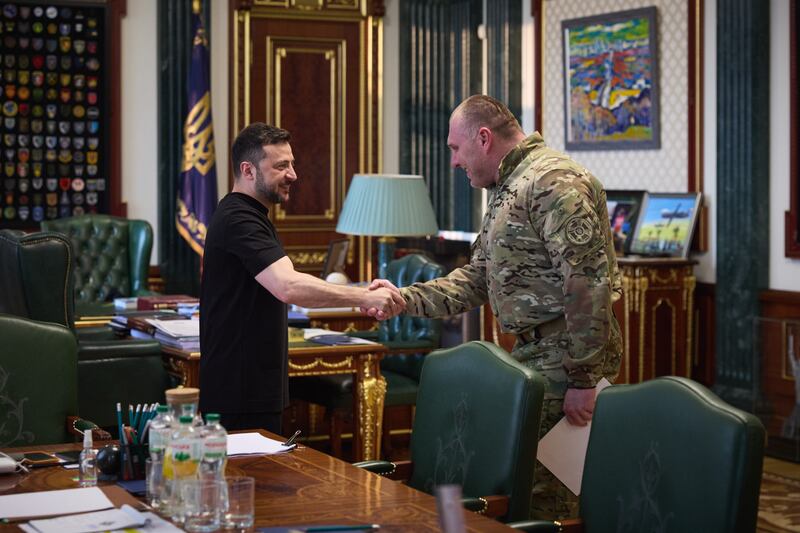Vladimir Putin might have thought he had succeeded in persuading Donald Trump that the Ukrainians had already lost the war against Russia. But an ingenious sneak attack targeting Putin’s most prized military assets proves otherwise and has dealt a blow to Russia’s nuclear deterrent.
Using small quadcopter drones, the Ukrainian intelligence service SBU simultaneously struck multiple strategic bombers and early warning aircraft at four separate airbases across the vast Russian landmass on Sunday.

The surprise attack is a military disaster and an embarrassment for the Russian president as he looks to pressure the U.S. and others to give up on Ukraine.
The nature of the clandestine operation would not go amiss in a later Tom Clancy novel. Codenamed “Operation Spider-Web,” the SBU drones were hidden in unattended cargo containers near the bases and began launching themselves one after another at Russian planes, including Soviet-era strategic bombers.

Footage posted to social media showed the cheap drones crashing into Russian aircraft, some of which were already ablaze. Ukrainian officials released a statement claiming that “34 percent of strategic cruise missile carriers at the main airfields of the Russian Federation were hit.”
Videos taken outside the base showed thick columns of smoke—and many of those planes, including Soviet-era TU-95 and TU-22M bombers, looked to be beyond repair.
Russia’s bomber fleet serves several purposes. Since 2022 it has been one of the main tools for Russian missile strikes at Ukrainian cities.
The bombers also serve a more vital purpose for Russia: as one of the main components of Russia’s nuclear deterrent alongside their nuclear missiles and submarines.
Until now, Ukraine has only managed to down a few bombers. The reported loss of 40 or more planes in a single day does not amount to the destruction of Russia’s entire bomber fleet, but it is a significantly larger blow to their inventory, and their pride.
Ukraine has struck nuclear-related early warning radar installations before, but Russia’s nuclear capabilities have never been called into question at this scale since the full-scale Russian invasion of 2022.
Just as important is the claim that the attack struck one or more of Russia’s A-50 early warning aircraft. These planes, while unarmed, are equipped with powerful radars that serve as the eyes and ears of the Russian air force, similar to the U.S. AWACS planes.
Worse still, Russia likely only has five such aircraft operational after Ukraine reportedly shot down two of them in early 2024. If any of them are even temporarily unavailable, it could change Russia’s air operations and reduce their awareness of Ukrainian air defense and their ability to find targets for the air force to bomb.
The strike, which Ukrainian President Volodymyr Zelensky said was 18 months in the planning, is a disaster for Russia as it seeks to promote a sense of strength ahead of another round of negotiations with Ukraine in Istanbul beginning Monday.
Putin had a lot to brag about in theory: The new U.S. administration is seemingly scared of punishing Russia for its attacks on civilians, his forces are pushing to take more Ukrainian territory, and he has dramatically increased the scale of drone attacks against Kyiv and other Ukrainian cities.
Now, the narrative of the conflict has temporarily shifted to Ukraine’s side. Even if an operation as complex as “Spider’s Web” cannot be replicated in the near term, Russia will still need to plan for contingencies and contend with Ukraine’s long-range drones, which routinely target Russian airfields.

How Russia will respond to the attack is an open question. Russian media is attempting to downplay or ignore the damage, but footage of the attacks is already widely available on social media.
Historically, the way Russia regains the narrative in the war is to punitively bomb Ukrainian civilians. The very first drone attack on Ukraine’s cities came after Kyiv successfully bombed the Russian-built bridge connecting Crimea to Russia.
Russia has already been scaling up its drone attacks on Ukrainian towns and cities, but Putin may opt to launch an even larger large salvo of missiles and drones to show the Russian bomber fleet is not entirely out of the fight.
Politically, Putin could try to use the strike to drive a deeper wedge between the U.S. and Ukraine, but it’s unlikely to work.
The White House claimed that they were not warned of the attack, but the mood in the White House has also seemingly shifted from blaming Ukraine to pleading with Russia to cease bombing Ukraine and work towards peace.
These factors make it more likely that the U.S. will prove indifferent to the strike.
For Russia, there is no silver bullet to protect its airbases from future acts of sabotage. The Kremlin cannot simply move all of its aircraft out of range—one of the bases struck was thousands of miles from the Ukrainian border.
They could redouble their efforts to build hardened shelters for their aircraft, but those will still take a while to finish. Or they could increase the number of air defense systems and jammers at their bases, at the risk of disrupting operations and diverting sorely needed counter-drone systems from the front line.
Whatever course the Russian military takes, they will have now to deal with the constant fear that Ukrainian drones will be over their heads.








